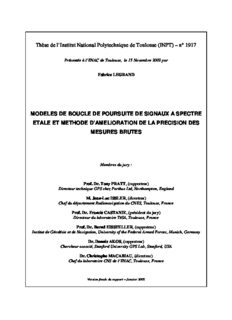
Spread spectrum signal tracking loop models and raw measurements accuracy improvement method PDF
Preview Spread spectrum signal tracking loop models and raw measurements accuracy improvement method
Thèse de l’Institut National Polytechnique de Toulouse (INPT) – n° 1917 Présentée à l’ENAC de Toulouse, le 15 Novembre 2002 par Fabrice LEGRAND MODELES DE BOUCLE DE POURSUITE DE SIGNAUX A SPECTRE ETALE ET METHODE D’AMELIORATION DE LA PRECISION DES MESURES BRUTES Membres du jury : Prof. Dr. Tony PRATT, (rapporteur) Directeur technique GPS chez Parthus Ltd, Northampton, England M. Jean-Luc ISSLER, (directeur) Chef du département Radionavigation du CNES, Toulouse, France Prof. Dr. Francis CASTANIE, (président du jury) Directeur du laboratoire TéSA, Toulouse, France Prof. Dr. Bernd EISSFELLER, (rapporteur) Institut de Géodésie et de Navigation, University of the Federal Armed Forces, Munich, Germany Dr. Dennis AKOS, (rapporteur) Chercheur associé, Stanford University GPS Lab, Stanford, USA Dr. Christophe MACABIAU, (directeur) Chef du laboratoire CNS de l’ENAC, Toulouse, France Version finale du rapport – Janvier 2005 Thesis of the Institut National Polytechnique de Toulouse (INPT), France Presented at ENAC, Toulouse, France, on November 15, 2002 by Fabrice LEGRAND SPREAD SPECTRUM SIGNAL TRACKING LOOP MODELS AND RAW MEASUREMENTS ACCURACY IMPROVEMENT METHOD Examining board: Prof. Dr. Tony PRATT, (thesis reviewer) GPS Technical Director at Parthus Ltd, Northampton, England Mr. Jean-Luc ISSLER, (thesis supervisor) Head of the Radionavigation department of the CNES, Toulouse, France Prof. Dr. Francis CASTANIE, Director of the TéSA Laboratory, Toulouse, France Prof. Dr. Bernd EISSFELLER, (thesis reviewer) Institute of Geodesy and Navigation at the University of the Federal Armed Forces, Munich, Germany Dr. Dennis AKOS, (thesis reviewer) Research associate with the Stanford University GPS Lab, Stanford, USA Dr. Christophe MACABIAU, (thesis supervisor) Head of the CNS Research Laboratory of the ENAC, Toulouse, France Final version of the report – January 2005 Avant-propos Etant donné que les rapporteurs de cette thèse sont non-francophones, le manuscrit est rédigé en anglais. Néanmoins, l’introduction, la conclusion, la table des matières ainsi que le résumé des chapitres sont rédigés en français. 5 Acknowledgments Author wish to thank the CENTRE NATIONAL D’ETUDES SPATIALES (CNES, the French Space Agency) and ALCATEL SPACE INDUSTRIES (ASPI) for having supported this research, and the ECOLE NATIONALE DE L’AVIATION CIVILE (ENAC, the French Civil Aviation School) for having provided accommodations during these years of work. I specially wish to thank my thesis supervisors M. Christophe MACABIAU and M. Abdelahad BENHALLAM from the ENAC, M. Jean-Luc ISSLER and M. Laurent LESTARQUIT from CNES, M. Christian MEHLEN from ASPI for having put trust in me and given lots of their time to support and help me. I also wish to thank M. Eric CHATRE, M. Jean-Marc LISEZ and M. Cyril DUPOUY from STNA for having provided technical assistance. Thanks to the students, the trainees and the staffs of the ENAC, and of course to my family and friends for their support and help. 7 Contents Avant-propos...............................................................................................................................................................................5 Acknowledgments.......................................................................................................................................................................7 Contents......................................................................................................................................................................................9 Tables des matières...................................................................................................................................................................13 INTRODUCTION..................................................................................................................17 Introduction...............................................................................................................................................................................19 CHAPTER I : RANGE MEASUREMENTS ON SPREAD SPECTRUM SIGNALS.....21 Chapitre I : Mesures de distance sur les signaux à spectre étalé................................................................................................21 I.1 INTRODUCTION AND DEFINITIONS ABOUT PSEUDORANGE AND RAW PHASE MEASUREMENTS.............................................................................................................................................22 I.1.1 DEFINITION OF THE PSEUDORANGE................................................................................................22 I.1.1.1 RANGE AND PSEUDORANGE..............................................................................................................22 I.1.1.2 ERRORS ON MEASURED PSEUDORANGE............................................................................................23 I.1.2 INTRODUCTION ON THE PSEUDORANGE MEASUREMENT TECHNIQUE...........................................25 I.1.2.1 PSEUDORANGE INFORMATION EXTRACTION.....................................................................................26 I.1.2.2 INTRODUCTION ON RECEIVER ARCHITECTURE..................................................................................26 I.2 MODEL AND PROPERTIES OF GNSS SPREAD SPECTRUM SIGNALS...............................28 I.2.1 MODEL OF A RECEIVED SIGNAL......................................................................................................28 I.2.1.1 GENERAL EXPRESSION.....................................................................................................................28 I.2.1.2 DYNAMICS MODEL...........................................................................................................................29 I.2.1.3 CARRIER TO NOISE RATIO.................................................................................................................31 I.2.2 SIGNAL PROPERTIES........................................................................................................................31 I.2.2.1 INSTANTANEOUS CARRIER FREQUENCY AND DOPPLER FREQUENCY SHIFT.......................................31 I.2.2.2 AUTOCORRELATION FUNCTION OF SPREADING SIGNALS...................................................................32 I.2.2.3 CROSS CORRELATION FUNCTION OF SPREADING SIGNALS.................................................................33 I.2.2.4 POWER SPECTRAL DENSITY..............................................................................................................34 Appendix of Chapter I...............................................................................................................................................................37 Appendix I-1: Maximal length sequences and Gold codes........................................................................................................39 Appendix I-2: Correlation functions of a PRN signal based on Gold codes..............................................................................41 CHAPTER II : SEQUENTIAL MODELS OF DIGITAL TRACKING LOOPS............45 Chapitre II : Modèles séquentiels des boucles de poursuite numériques...................................................................................45 II.1 CARRIER PHASE TRACKING WITH COSTAS LOOP..............................................................46 II.1.1 MIXING WITH THE LOCAL SIGNALS / IQ DECOMPOSITION............................................................47 II.1.2 PREDETECTION FILTERING.............................................................................................................47 II.1.3 PHASE DISCRIMINATORS.................................................................................................................52 II.1.4 LOOP FILTERING.............................................................................................................................53 II.1.5 LOCAL SIGNALS GENERATION........................................................................................................54 II.1.6 DATA DEMODULATION....................................................................................................................55 9 II.2 CODE TRACKING WITH DELAY LOCK LOOPS......................................................................57 II.2.1 CODE CORRELATORS......................................................................................................................58 II.2.2 CODE PHASE DISCRIMINATORS.......................................................................................................59 II.2.3 LOOP FILTERING.............................................................................................................................61 II.2.4 LOCAL CODE GENERATION.............................................................................................................61 II.3 SIMULTANEOUS CODE AND CARRIER PHASE TRACKING LOCK LOOPS.....................63 II.4 GAUSSIAN NOISE IN THE LOOPS...............................................................................................64 II.4.1 RF FILTERING EFFECT....................................................................................................................64 II.4.2 IN-PHASE AND QUADRATE BASEBAND NOISES.................................................................................65 II.4.3 CORRELATOR OUTPUT NOISES........................................................................................................66 Appendix of Chapter II.............................................................................................................................................................67 Appendix II-1: Series expansions of sine and cosine functions.................................................................................................69 Appendix II-2: Gaussian noise in the loops...............................................................................................................................73 CHAPTER III : SAMPLED PHASE PROPAGATION MODELS..................................79 Chapitre III : Modèles discrets de propagation de la phase.......................................................................................................79 III.1 TRADITIONAL DIGITAL CONSTANT-RATE MODEL............................................................80 III.1.1 GENERIC CLOSED LOOP MODEL......................................................................................................80 III.1.1.1 MODEL OF THE DISCRIMINATOR.......................................................................................................80 III.1.1.1.1 Generic non-linear model.................................................................................................................................80 III.1.1.1.2 Linear model....................................................................................................................................................81 III.1.1.2 DIGITAL LOOP FILTER.......................................................................................................................81 III.1.1.3 NCO MODEL....................................................................................................................................81 III.1.2 LINEAR CLOSED LOOP MODEL........................................................................................................82 III.1.3 LINEAR TRANSFER FUNCTIONS.......................................................................................................83 III.2 PROPOSED MULTI-RATE MODEL INCLUDING INTEGRATE & DUMP PREDETECTION FILTERS..............................................................................................................................85 III.2.1 DESCRIPTION OF THE MODEL.........................................................................................................85 III.2.1.1 GENERIC CLOSED LOOP MODEL........................................................................................................85 III.2.1.2 MODEL OF THE DISCRIMINATOR INCLUDING THE I&D PREDETECTION FILTERS................................85 III.2.1.3 MODEL OF THE NCO WITH A HELD COMMAND SIGNAL....................................................................86 III.2.1.4 CLOSED LOOP MODEL.......................................................................................................................86 III.2.1.5 LINEAR TRANSFER FUNCTIONS AS A FUNCTION OF THE LOOP FILTER ORDER....................................89 III.2.1.6 VALIDATION OF THE NEW LINEAR MODEL........................................................................................91 III.2.2 EVALUATION OF THE TRACKING ERROR........................................................................................95 III.2.2.1 SENSITIVITY ON NOISE......................................................................................................................95 III.2.2.1.1 Phase noise model............................................................................................................................................95 III.2.2.1.2 Equivalent noise bandwidth of the loop...........................................................................................................96 III.2.2.1.3 Expression of the equivalent noise bandwidth as a function of the loop filter coefficients..............................99 III.2.2.2 SENSITIVITY TO DYNAMICS............................................................................................................103 III.2.2.2.1 Expression of the steady state error................................................................................................................103 III.2.2.2.2 Definition of the Steady State Error Factor....................................................................................................105 III.2.2.3 TOTAL TRACKING ERROR...............................................................................................................106 Appendix of Chapter III..........................................................................................................................................................109 Appendix III-1: Multi-rate linear model simplifications.........................................................................................................111 Appendix III-2: Loop filter coefficients expressed as a function of the poles of the loop transfer function – Usual digital constant rate model..................................................................................................................................................................115 Appendix III-3: Equivalent initial value of the mth derivative of the averaged input phase.....................................................119 Appendix III-4: Generic Expressions of the linear transfer functions derived from the multi-rate model of loops.................121 10
Description: